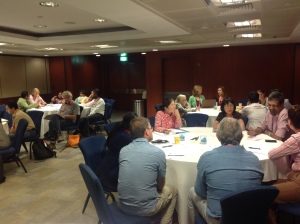 “Come over for a discussion on overdiagnosis and contribute your ideas to tackle it,” was the invitation. A diverse mix of doctors, nurses, researchers, public health practitioners, and students from countries across the world got together for our workshop at the 22nd Cochrane Colloquium in Hyderabad.
“Come over for a discussion on overdiagnosis and contribute your ideas to tackle it,” was the invitation. A diverse mix of doctors, nurses, researchers, public health practitioners, and students from countries across the world got together for our workshop at the 22nd Cochrane Colloquium in Hyderabad.
Overdiagnosis, like many medical conditions, lacks clear parameters. How much is too much, really?
To get real examples, we asked participants to share instances of overdiagnosis and overtreatment that they had come across. And these were many, spread across different specialties and domains of healthcare. Mostly, these had an element of providing unnecessary care, which was wasteful of resources and potentially harmful. One example that stood out for me was that of undernutrition being overdiagnosed in low and middle income countries—after the application of parameters from populations in rich countries—which resulted in a range of possibly unnecessary interventions.
Although there was a wide range of examples of overdiagnosis, when we asked participants to identify potential factors driving overdiagnosis they fitted into a few broad categories. Money, as expected, came out on top. Financial motives have clearly distorted medical practice worldwide.
Industry has been complicit in selling the idea of sickness to create a market for varied products and services. Corporate hospitals too, as some participants asserted, are capitalising on the idea of prevention to promote extensive health check-ups of uncertain benefit. The media is often employed by industry, but has itself also promoted an image of health and fitness that drives people to seek medical interventions.
An interesting observation was the role of politicians, or indeed, the government, where providing medical services may be a quick and easy way to garner votes. A lighthearted observation by one doctor was how administrators at her hospital expected them to overtreat a condition to ensure an expensive machine they had invested in was used enough to justify its costs. Clearly, the drivers of “too much medicine” are complex.
The two categories of drivers that I was most sympathetic to were those attributed to clinicians and patients. Participants argued that doctors may be driven by the need to “save their skin” and hence practised defensive medicine. Some felt that doctors lack guidelines which are clear enough to reliably use for each patient. Uncertainties are really the nature of clinical practice that doctors need to get comfortable with. A few felt that doctors are expected to “do something” rather than “wait and watch,” which pushes them to provide unnecessary care.
Patients were identified to be important drivers of overdiagnosis by expecting, and often demanding, that medical investigations and procedures be done or some treatment given. Examples ranged across diseases, including intrauterine insemination for infertility, MRI for knee pain, treatment for hyperlipidaemia, CT scan for low back pain, antibiotics for a common cold, or intervention for elevated prostate specific antigen.
On reflection, I am not sure that patients should take the blame for this. Patients are in a way consumers, and the medical establishment exists to serve them. So, demanding care, which is judged to be appropriate from their perspective, may not be improper. But the weight of responses made me feel that it is sensed to be so. In retrospect, I wonder if this discourse, like many healthcare platforms, lacked the voice of patients. Possibly, they would not be seen as “expecting treatment” if they felt more informed and reassured by their doctor’s plan of management, and trusted their doctor.
Bridging this gap between doctors and patients is what is being attempted through the Choosing Wisely initiative. Health professionals in some countries have taken on the challenge of reflecting on practices in their specialties so they can identify those that may be wasteful and educate patients too. One participant also mentioned the Sunshine Act in the United States, which aims to provide greater transparency on financial incentives that may be driving unnecessary care.
Before we could conclude, a brave young doctor shared how uncomfortable the session had made him feel. Throughout medical training and under the guidance of seniors in practice, the focus had always been on picking up the signs of disease and reaching a diagnosis. The concept of overdiagnosis seemed to throw those learning principles into question. Others concurred on the need to introduce these concepts early on in medical school. Identifying and measuring overdiagnosis is clearly not easy, and is made more difficult in the dynamics of clinical practice.
Anita Jain is India editor, The BMJ.
Competing interests: Nothing to declare.
I am grateful to Trish Groves for facilitating this workshop along with me and for her inputs on this write-up.